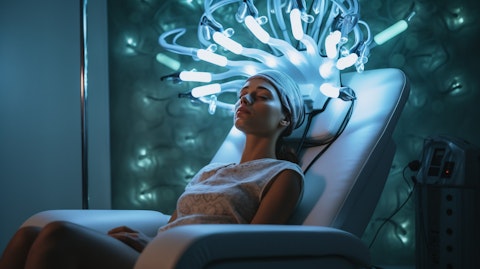COMPASS Pathways plc (NASDAQ:CMPS) Q1 2024 Earnings Call Transcript May 11, 2024
COMPASS Pathways plc isn’t one of the 30 most popular stocks among hedge funds at the end of the third quarter (see the details here).
Operator: Thank you for standing by, and welcome to the COMPASS Pathways’ First Quarter 2024 Earning Investor Call [Operator instructions]. As a reminder, today’s program is being recorded. And now I’d like to introduce your host for today’s program, Mr. Stephen Schultz, Senior Vice President, Investor Relations. Please go ahead, sir.
Stephen Schultz: Welcome all of you. And thank you for joining us today for our first quarter 2024 results conference call to. Again, my name is Steve Schultz, Senior Vice President of Investor Relations at COMPASS Pathways. And today, I’m joined by Kabir Nath, our Chief Executive Officer; Dr. Guy Goodwin, our Chief Medical Officer; and Teri Loxam, our Chief Financial Officer. The call is being recorded and will be available on the COMPASS Pathways’ Investor Relations website shortly after the conclusion of the call and will be archived for a period of 30 days. Before we begin, let me remind everyone that during the call today, the team will be making forward-looking statements within the meaning of the Private Securities Litigation Reform Act of 1995 as amended.
You should not place undue reliance on these forward-looking statements. Actual events or results could differ materially from those expressed or implied by any forward-looking statements as a result of various risks, uncertainties and other factors, including those risks and uncertainties described under the heading Risk Factors in our Annual Report on Form 10-K filed with the U.S. Securities and Exchange Commission and in subsequent filings made by COMPASS with the SEC. Additionally, these forward-looking statements represent our views only as of today and should not be relied upon as representing our views as of any subsequent date. We specifically disclaim any obligation to update or revise any forward-looking statements even if our estimates or assumptions change.
I’ll now hand the call over to Kabir Nath.
Kabir Nath: Thanks, Steve. Good day, everyone, and thank you for joining us. First, let me report that COMPASS continues to execute on both of the Phase III COMP360 trial in treatment-resistant depression. We’re on track to deliver top line data for the COMP 005 single-dose placebo-controlled study in the fourth quarter of this year. And for the COMP 006 fixed repeat dose trial in mid-2025. We’re also actively working on completing all necessary preclinical and clinical pharmacology studies required for a COMP360 and NDA dossier. Also in this quarter, we announced additional commercial collaborations with leading mental health care providers, designed to inform the development of scalable and cost-effective delivery models for COMP360 psilocybin treatment, if approved, for treatment-resistant depression.
The most recent announcements of the Journey Clinical and Mindful Health Solutions collaborations add to those we already have in place with Reliant Medical Group, part of OptumCare, Greenbrook TMS, and Hackensack Meridian Health. Each of these partners represent very different, but equally important commercial models and setting of care for patients. These collaborations are focused on investigating challenges with the current patient care experience. They will assist COMPASS and these leading metal health care providers to better understand how COMP360 may best fit into diverse care setting and also enable COMPASS to develop commercial delivery templates in these different care settings. These collaborations, plus the CPT III tracking code that went into effect in January are important steps towards preparing the market for a COMP360 psilocybin treatment option, if approved.
Let me now hand the call over to Dr. Guy Goodwin for a clinical update. Guy?
Guy Goodwin: Thank you, Kabir. It’s a pleasure to speak to everyone today and review the positive data generated from the COMP360 Phase II clinical study in PTSD. We hope you have the opportunity to review the press release from this morning summarizing the results. This study included three clinical sites in the US and the UK, the Icahn School of Medicine at Mount Sinai in New York, Sunstone Therapies in Rockville, Maryland, and the Institute of Psychiatry, Psychology & Neuroscience at King’s College in London. Now let me go through some of the specific results we saw with this PTSD study. The study was an open-label multicenter Phase II exploratory study evaluating COMP360 psilocybin treatment in 22 patients with PTSD resulting from trauma in adulthood.
Participants received a single 25-milligram dose along with psychological support. Psychological support was provided by a licensed medical professional to ensure patient safety by preparing participants for the treatment session, observing and being present with patients during the session and supporting them after the session. The majority of patients entered the study with symptoms of PTSD categorized as severe with a mean CAPS-5 total score at baseline of 47.5. The CAPS-5 assessment involves a structured interview that provides a PTSD diagnosis aligned with DSM-5 and measure the average severity of 20 symptoms. The average age of participants at the time of screening was 39, and four participants had prior lifetime experience with psilocybin.

Veteran status and combat exposure were evaluated as were measures of the dissociative PTSD subtype. Patients diagnosed with complex PTSD were excluded from study eligibility. The effects of the COMP360 treatment on the CAPS-5 score were assessed at week four and again week 12 to assess durability of effect. Study observations also included an improvement from baseline in mean SDS score, a measure of functional impairment in daily life. Safety over 12 weeks was the primary endpoint of this study and administration of COMP360 in this patient group was well tolerated with no serious adverse events observed. We’re also pleased to report impressive and sustained rates of response and remission at both week four and week 12. The key findings include administration of COMP360 was well tolerated.
There were no treatment emergent serious adverse events. Treatment emergent adverse events over 10% included headache, nausea, crying and fatigue, predominantly on the day of drug administration. There were two events of suicidal ideation that resolved during the study. The first was a moderate and transient event on administration day in a patient who went on to be a responder. The second event was mild and occurred at week seven in a non-responder. As a reminder, suicidal ideation is a common feature of PTSD as it is in TRD. We observed an early and durable improvement in symptoms from baseline following a single administration. Improvement in mean CAPS-5 total score from the baseline of 47.5 was observed with a 29.9 point reduction at week four and 29.5 reduction at week 12.
We observed increasing improvement in disability over the 12 weeks. From a mean SDS total score of 22.7 at baseline, there was an 11.7 point reduction at week four and a 14.4 point reduction at week 12. We also saw high and sustained rates of response and remission relative to baseline with early onset of symptom improvement. Response, as defined by patients experience, a greater or equal 15 point improvement on CAPS-5 score was 81.8% at week four and 77.3% at week 12. Remission as defined by CAPS-5 total score of less than or equal to 20, was 63.6% at week four and 54.5% at week 12. No patients withdrew from the study are none returned to antidepressant medications during the trial. Although a small trial with open-label design, the results exceeded our expectations and advanced our understanding of potential application of COMP360 in PTSD.
We were particularly impressed by the early onset and durability of improvement. We believe that COMP360 could provide a clinically meaningful benefit and substantially improve daily function and quality of life in patients with PTSD. We look forward to submitting the full results of this study for publication and will consider next steps for the program. In addition, to TRD as Kabir mentioned, we are on track for the primary six week endpoint in COMP 005 during the fourth quarter of this year. We are seeing improvements from the actions we took to facilitate the retreatment of medical records, which created a bottleneck earlier in the year. We also remain on track for COMP 006 for the prior 6-week endpoint mid next year. We are excited by the profile that’s emerging for COMP360 across both TRD and PTSD and the potential benefit for patients.
We look forward to our Phase III results later this year and next year and continuing to progress the broader COMP360 program. Let me now hand the call to Teri for a financial review.
Teri Loxam: Thanks, Guy. I’ll now step through the Q1 financial results. Cash used in operations in the first quarter was $20.8 million, within the guidance range we provided of $17 million to $23 million and which assumes that 2022 R&D tax credit would be received in the first quarter. I’m pleased to confirm that HMRC paid our 2022 claim of approximately $15 million in full in the first quarter. Regarding second quarter 2024 financial guidance, we expect net cash used in operations to be between $32 million and $38 million. Turning to full year financial guidance, we expect cash used in operations to be between $110 million and $130 million. COMPASS continues to maintain a strong financial position with cash and cash equivalents of $262.9 million at March 31, 2024.
This compares with $220.2 million at December 31, 2023. The increase in cash in the first quarter is due to proceeds received through the ATM and exercise of warrants from our August 2023 pipe. Long-term debt under Hercules loan facility was $29.1 million at the end of the first quarter. With the cash increase in the first quarter, we now expect our cash runway to fund operations into 2026. We will continue to manage our cash carefully to continue advancing our pivotal program and to achieve important milestones that we believe will create value for our shareholders. Thank you, and I’ll now turn the call back to Kabir.
Kabir Nath: Thank you, Teri. With these strong PTSD data, we’re now working to schedule a meeting with the FDA and align on potential mix steps. While TRD is our lead indication for COMP360, we see logical expansion into PTSD, given the similarities in patient profiles and the potential commercial synergy. We’re looking forward to disclosing our top line data for our Phase III program later this year. This will be a key milestone for COMPASS and given our leadership a significant event for the field of psilocybin science. We also continue to make great progress with the network of interventional psychiatry centers and mental health care providers who can administer COMP360 treatment, if approved. Our expanding collaboration are indications of interest from providers, and we’ll continue to develop commercial models that enable rapid, scalable, broad and equitable access to COMP360.
I also want to welcome Dr. Mike Gold to the COMPASS team as our new Chief Research and Development Officer, effective May 20. Mike brings more than 25 years of experience across all aspects of drug development in neuroscience, with extensive therapeutic experience in neurological and psychiatric disorders, including depression. Mike will work with Guy to continue to develop COMP360 in TRD and other indications and to explore and advance other potential pipeline opportunities. I want to thank Trevor Mill, COMPASS’ current Chief Development Officer, for his dedication and expertise in guiding the development of our COMP360 program over the past several years and exploring additional early pipeline opportunities. Trevor will leave after a transition period with Mike, and we wish him all the best in his future endeavors.
This is an exciting year for COMPASS Pathways, and we look forward to updating you on our continued progress. Thank you again for your participation on today’s call. We’ll now turn to Q&A, so I’ll hand it back to the operator.
See also 15 Best Places to Retire in New York and 20 Countries with the Highest Pupil-to-Teacher Ratio in the World.
Q&A Session
Follow Compass Pathways Plc (NASDAQ:CMPS)
Follow Compass Pathways Plc (NASDAQ:CMPS)
Receive real-time insider trading and news alerts
Operator: And our first question comes from the line of Vikram Purohit from Morgan Stanley.
Vikram Purohit: So we had 21 PTSD. So first, could you just frame for us in terms of real-world experience and real-world benefit, what the CAPS-5 and SDS scores that you reported this morning, how to contextualize those in terms of the benefits that patients may observe. And then also another company in the space recently received notice that the FDA is going to be scheduling an Ad Comm meeting for early June to review their application for their MDMA assisted therapy for PTSD. Just wanted to see what your thoughts were there on potential implications for your program in the space more broadly?
Stephen Schultz: As we start, I just want to make sure you can hear us clearly.
Vikram Purohit: Yes.
Kabir Nath: So I’ll hand to Guy to take the first question and maybe the second one I might add on that as well. Guy?
Guy Goodwin: So I think the way to think about these results is that they reflect the real near return to normality for a significant number of patients in the study. I mean, these rating scales are not terribly familiar. So we’re all getting to understand them as we go along. But basically, they reflect the lowest scores that we see, reflect essentially complete recovery. The average, of course, is not that there’s a range of outcomes, but we emphasize, I think, that these very high rates of remission as defined by a minimum score are high. And we think that’s important also that they’re sustained. I think I would also draw your attention to the SDS scores. They reflect a measure of disability that is used across trials. And so that allows you to look at the impact of other treatments in other conditions as well as potentially in PTSD.
That again reflects the numbers that we show reflect substantial return of function for patients, which is as important as a reduction of symptoms of course. The second question about Lykos.
Kabir Nath: Yes, I mean let me take that. I mean, I think first, no surprise. This is, as said, the first submission in PTSD for more than 1/4 of a century, number one. Second, it is they’re currently a Schedule I drug. So in that sense, no surprise that there is going to be an Ad Comm. And I would just say we wish them well. And obviously, we, like many other people will be observing very closely how the FDA pauses a number of the key questions around that application.
Operator: And our next question comes from the line of Ritu Baral from TD Cowen.
Ritu Baral: Quick thing on potential positioning versus the Lykos compound and MDA assisted psychotherapy. Kabir and Guy, could you walk us through sort of the nature of the psychological support that you provide? Was there any aspect of exposure therapy, which from my understanding is sort of the basis for the psychological support provided by Lykos. If you could talk to like the amount and then the nature. And then I have a follow-up.
Kabir Nath: I’ll hand it down in a moment. But I mean, the headline, Ritu, it is no different from what we’re doing in TRD. But, Guy, please?
Guy Goodwin: In fact, we have quite a detailed follow-up questionnaire there, which we’ll be publishing the results from in due course. And what that suggests is that essentially patients do not really have the same kind of exposure experience. There’s a little bit of that, but mainly there is really just a change in the way people contextualize their memories and their experience. And that seems to be essentially driven by this inward journey that everyone has heard about in relation to psilocybin. So patients are prepared in the same way as we prepare the TRD group, as you’ve heard. There’s no a specific exposure exercises as would occur with the conventional psychotherapy. And patients indeed remark, who have had previous psychotherapy in contrast to that, but they feel that they are in a sense of doing their own work.
That they are leading themselves and they’re not being driven by an external interactive force, which would be the therapist in conventional psychotherapy. So it’s a very interesting contrast of the preparation, of course, in terms of hours and so on and the subsequent integration is relatively short. And we think that the efficacy is remarkable given that it’s sustained after 12 month.
Ritu Baral: And then can you just talk about some of the exclusion criteria as it relates to suicidality. Did you — were you able to see patients with a history of suicidality? Was there anything unique in the history of those two patients that did experience suicidality?
Guy Goodwin: I mean, this is a group, even though this is not complex PTSD, because this was really a first study, we wanted to be careful not to recruit two vulnerable patients in the severe probably the complex PTDS group with BDAP. So this is a single trauma, which also simplifies the measure of outcome. But these patients also show significant history of suicidality. So 70% of them have expressed in their lifetimes a wish to be dead, and as many as 30% of them have expressed active suicidal ideation with specific plans and intent. So this is a group that has lifetime suicidality as a feature of the illness. The particular group were obviously recruited at the stage where they were not suicidal, and therefore what we’re seeing is relatively sub-threshold effects. So there were no serious adverse events, and of course, there were no attempted suicide or suicides, which unfortunately is a risk in this condition.
Ritu Baral: And if I could have just one quick follow-up, and a follow-up to the first question, Kabir, you left us hanging when you said you would have some key questions that you’d love to have answered by the Lykos Ad Comm. Can you elaborate a little further on that? What questions do you have that you hope Ad Comm addresses.
Kabir Nath: Well, one thing, and again, it’s up to them to comment on how they think that will go. But clearly, and as we’ve said this before, the Lykos’ protocol is therapy. And in fact, your question itself probed at the fact that there is a significant therapeutic component, and that clearly is something that will be interesting to see how the FDA understands that, parses that, and ultimately, if that’s successful, how that will be reflected in labeling and so on. I think that’s probably the key question, as well as clearly the overall assessment of benefit-risk for what is generally categorized as a psychedelic. So again, we could get into arcade arguments about that. But I think, again, how the FDA approaches the overall benefit risk…
Operator: And our next question comes from the line of Charles Duncan from Cantor.
Charles Duncan: Kabir and team, congrats on the progress. I had a question on PTSD and then one on TRD. On the PTSD data seems fairly robust. So I guess at the risk of jumping the gun, I know that you are seeking FDA input, but could you imagine a relatively capital-efficient Phase III program, maybe including one or 2 studies, both with less than, say, roughly 90 patients given the, call it magnitude of change that you’re seeing in CAPS-5.



